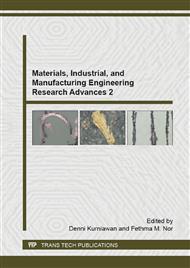p.455
p.460
p.465
p.470
p.474
p.479
p.484
p.489
p.494
Effect of Calcination on the Properties of Hydroxyapatite from Tilapia Fish Bones
Abstract:
The present work focus on study of the effects of calcination temperatures (600, 800, 1000, and 1200°C) on derived natural hydroxyapatite from different parts of tilapia fish bones. The calcined samples were characterized regards to their chemical and structural properties. The XRD result revealed the presence hydroxyapatite (HAp) from the calcined samples and were identical to the standard HAp pattern. The FT-IR spectra confirmed that all organic materials and water molecule present in raw samples were completely eliminated during the calcination process at 600°C. SEM results show the surface morphology of calcined samples as compared to raw samples. The HAp was fully formed when samples were calcined at 800°C. The increasing temperature had led to the formation of mixtures of hydroxyapatite (Ca10(PO4)6(OH)2) and β-Tricalcium phosphate (Ca3(PO4)2, β-TCP). The degree of crystallinity and crystallite size gradually increased with the calcination temperature. Calcined Fin and head were found to have great potential in the extraction of biological HAp. The findings are the promising alternative to produce pure hydroxyapatite from marine wastes at a suitable temperature that beneficial to medical applications. The present work focus on a study of the effects of calcination temperatures (600, 800, 1000, and 1200°C) on derived natural hydroxyapatite from different parts of tilapia fish bones. The calcined samples were characterized regards to their chemical and structural properties. The XRD result revealed the presence hydroxyapatite (HAp) from the calcined samples and were identical to the standard HAp pattern. The FT-IR spectra confirmed that all organic materials and water molecule present in raw samples were completely eliminated during the calcination process at 600°C. SEM results show the surface morphology of calcined samples as compared to raw samples. The HAp was fully formed when samples were calcined at 800°C. The increasing temperature had led to the formation of mixtures of hydroxyapatite (Ca10(PO4)6(OH)2) and β-Tricalcium phosphate (Ca3(PO4)2, β-TCP). The degree of crystallinity and crystallite size gradually increased with the calcination temperature. Calcined Fin and head were found to have great potential in the extraction of biological HAp. The findings are the promising alternative to produce pure hydroxyapatite from marine wastes at a suitable temperature that beneficial to medical applications.
Info:
Periodical:
Pages:
474-478
Citation:
Online since:
October 2015
Authors:
Keywords:
Price:
Сopyright:
© 2015 Trans Tech Publications Ltd. All Rights Reserved
Share:
Citation:


